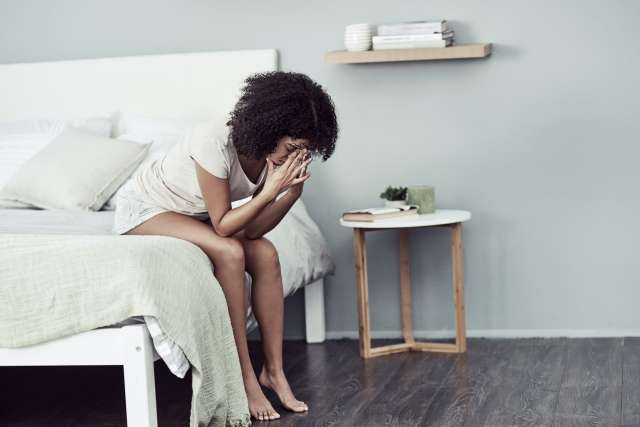Premenstrual discomfort is a feeling many people assigned female at birth know well. Nearly 90% of women in the United States have uncomfortable symptoms before their period — one-third of them report symptoms that qualify as premenstrual syndrome (PMS). But if your PMS symptoms are severe and impact daily life, you may have premenstrual dysphoric disorder (PMDD).
“When you have PMDD, please know there’s no immediate life-threatening health concern. There’s nothing on your uterus, and nothing has happened to your ovaries other than perhaps an abnormal response to normal hormone changes,” says UCLA Health OBGYN Quy Nguyen, MD. “But it can greatly affect your quality of life, and you don’t have to live with it.”
What is PMDD?
PMDD is a group of physical and behavioral symptoms that show up in a recurring pattern, usually during the second half of your menstrual cycle. Experts aren’t sure what causes PMDD or why only about 5% of women develop it. But many believe it’s related to hormones and neurotransmitters (the brain’s chemical messengers).
“During your menstrual cycle, you experience rising and dropping of both estrogen and progesterone levels. Your body is sensitive to those hormonal changes,” Dr. Nguyen says. “And studies have shown that your menstrual cycle may also influence the neurotransmitters, like serotonin, in your brain.” The impact on neurotransmitters can lead to behavioral symptoms, such as anxiety, depression or trouble controlling your emotions.
There are proven risk factors that increase your likelihood of developing PMDD, including:
- Cigarette smoking
- Obesity
- Past traumatic events
- Pre-existing anxiety disorders
PMDD vs. PMS
It’s easy to mistake PMDD for PMS — many physical signs are the same. But PMDD also includes debilitating emotional and mood-related symptoms.
“The main thing that sets PMDD apart from PMS is how severely it can affect your quality of life,” Dr. Nguyen says. “If you’re wondering if you have PMS or PMDD, ask yourself how your symptoms impact your life. Are you missing work, missing school or unable to socialize?” If so, you may be living with PMDD.
PMDD symptoms
People with PMDD have severe symptoms for about six-and-a-half days during each menstrual cycle. That can amount to eight years of disabling symptoms over a lifetime.
The signs of PMDD can include:
- Common physical symptoms of PMS, such as cramps, bloating, breast tenderness and headaches
- Feelings of depression, sadness and despair (including suicidal thoughts)
- Feelings of tension and anxiety, with possible panic attacks
- Joint or muscle pain
- Low energy, exhaustion and no interest in daily activities or relationships
- Mood swings that affect other people and may include irritability, anger, crying or feeling out of control
- Trouble sleeping
“The list of possible PMDD symptoms is long, but it’s helpful to see the range,” Dr. Nguyen says. “It’s never just one symptom that someone mentions. It’s always a wide spectrum of symptoms that appear at the same time each month.”
How to know if you have PMDD
There is no test for PMDD. But the criteria for diagnosis include five or more emotional and physical symptoms — and one must be mood-related. People with PMDD also experience their symptoms in two consecutive menstrual cycles.
But it’s important to distinguish PMDD from other possible underlying conditions. Dr. Nguyen typically conducts lab work to check for issues like hypothyroidism or hyperthyroidism, which can have similar symptoms to PMDD. But the most crucial factor in diagnosis is a symptom log that notes their severity and when they come and go in relation to menstruation.
“PMDD symptoms completely resolve at the beginning of your period or shortly after,” Dr. Nguyen says. “If you have anxiety or depression or another underlying condition, and not PMDD, the symptoms can sometimes feel better during your period, but they never resolve completely.”
PMDD treatment
Since PMDD symptoms can range from moderate to severe, many treatment options are available.
Non-prescription treatment options include:
- Exercise, which can reduce stress, anxiety and depression symptoms
- Over-the-counter pain relievers (such as ibuprofen and naproxen), which can help relieve physical symptoms
- Relaxation therapy, such as meditation and hypnosis
- Vitamin and mineral supplements, such as vitamin B6 — which helps create serotonin and other neurotransmitters
Prescription medications tend to be more effective at treating PMDD and include:
- Antidepressants called SSRIs (selective serotonin reuptake inhibitors), which alter serotonin levels
- Birth control pills, which relieve typical PMS symptoms and can help you skip menstruation so you don’t undergo the cycling of hormone levels
- Ovarian suppression medications, which stop ovaries from making estrogen and progesterone to put your body into temporary menopause
“Studies show that 60% to 70% of women notice improved PMDD symptoms after taking prescription medication,” Dr. Nguyen says. “You can take an SSRI every day, or you can just take it during the second half of your menstrual cycle and that may be sufficient.”
But the first step in treating the symptoms of PMDD is talking to your physician. They can guide you in tracking your symptoms and test you for other underlying conditions.




